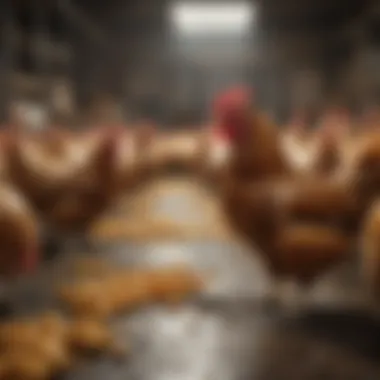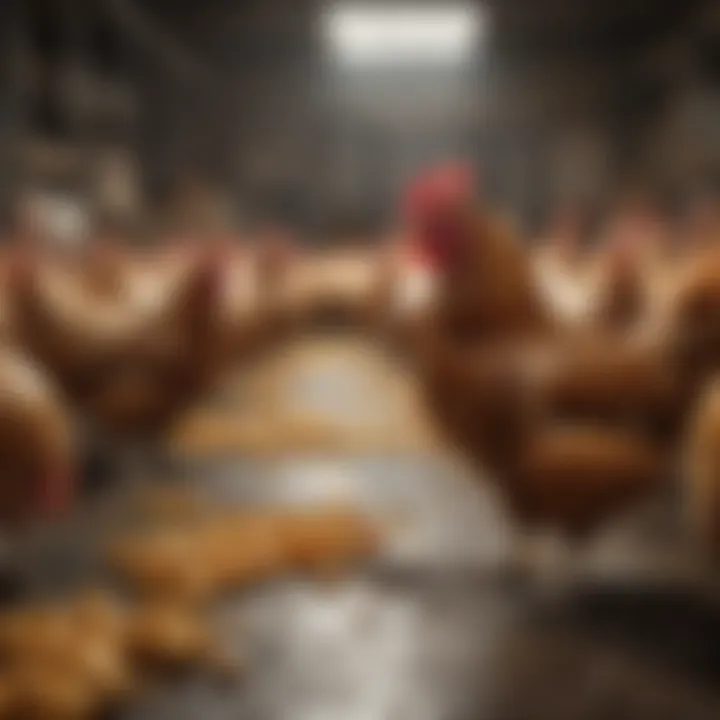Analyzing Chicken Commodity Price Trends and Influences


Intro
Chicken has become one of the most widely consumed meats in various parts of the world. The dynamics surrounding chicken commodity prices influence everything from farm operations to supermarket pricing strategies. For farmers, understanding these costs is vital for maintaining sustainable practices and ensuring profitability. Consumers, too, are affected; they experience fluctuations at the grocery store that ripple through their budgets. This article promises to take you on a detailed journey through the factors affecting chicken commodity prices, moving beyond mere numbers to unveil the intricate web of influences and implications.
Topic Overview
Definition and Importance
Understanding chicken commodity prices involves grasping how market forces, production costs, and consumer demand intersect. Commodity prices reflect not just the cost to produce chicken but also encompass broader economic indicators that influence the agricultural sector. In this landscape, small variations in any one factor can lead to significant price changes, making the topic both complex and essential for stakeholders.
Brief History and Evolution
The chicken market has not always been the thriving sector it is today. A few decades ago, consumer preferences leaned heavily toward red meats like beef and pork. However, a shift began, spurred by changing dietary trends and a growing awareness of health benefits associated with poultry. Over time, advancements in breeding, feeding, and farming practices have fueled supply, making chicken accessible and affordable for many. This evolution not only broadened consumer options but also set the stage for modern challenges and opportunities in pricing.
Key Techniques and Innovations
Sustainable Farming Practices
The farming community is increasingly focusing on sustainable approaches that not only enhance productivity but also consider environmental impact. For instance, many farmers are shifting towards integrated pest management and organic feed. These practices may incur initial costs but can lead to long-term savings through improved chicken health and better yield management. Here are a few sustainable techniques:
- Rotational grazing to reduce feed costs and improve soil health.
- Utilizing waste materials, such as chicken litter, as organic fertilizers.
- Emphasizing animal welfare to enhance product quality and consumer trust.
Advanced Agronomic Technologies
Technology plays a significant role in the evolution of chicken farming. Precision agriculture allows for more efficient resource use and optimized production strategies. Examples include:
- Data Analytics: Monitoring growth and health parameters in real-time.
- Automated Feeding Systems: Reducing labor costs and minimizing waste.
- Biotechnology: Enhancing disease resistance in chicken breeds, leading to healthier flocks and lower mortality rates.
Practical Applications
Step-by-Step Guides
- Assess your current farming practices: Identify areas to implement sustainable methods or technology.
- Research local and global market trends related to chicken supply and demand.
- Create a budget that accommodates potential shifts in prices and costs.
- Engage with local agricultural extension services for tailored advice and support.
Case Studies or Real-World Examples
One notable case is from a poultry farm in Iowa that implemented solar energy solutions to power their operations. This move not only reduced operating costs significantly but also made them more resilient to fluctuations in energy prices. Similarly, a cooperative in North Carolina adopted technology to monitor feed efficiency, leading to healthier chickens and better profit margins in challenging market conditions.
"The chicken industry is like a living organism, constantly evolving and adapting to the pressures of both market demand and production capabilities."
In summary, as we navigate the complexities surrounding chicken commodity prices, it becomes clear that a concise understanding of history, techniques, and practical applications allows stakeholders to make informed decisions. Whether one is a farmer or a consumer, recognizing the factors at play contributes to a more robust understanding of this essential commodity.
Preamble to Chicken Commodity Prices
The world of chicken commodity prices is not just a niche topic reserved for market analysts or farmers; it carries significant weight across various sectors, from consumers to global trade. Understanding these prices can illuminate a broader picture, highlighting how they impact everything from local grocery costs to farmers’ profitability, making it crucial for anyone involved in agriculture or the food industry.
This article aims to unpack the intricacies of chicken pricing, delving into the forces that influence market fluctuations. The analysis goes beyond mere figures, exploring the underlying trends and factors influencing these prices.
Definition and Importance
Chicken commodity prices refer to the market values assigned to chicken products, which fluctuate based on numerous economic, environmental, and social factors. Understanding this definition is foundational, as it helps stakeholders recognize the implications of price movements. For farmers, higher commodity prices may signal profitability, while consumers often feel the pinch at the check-out, leading to thoughtful purchasing behavior.
To put it simply, fluctuations in chicken prices can be as indicative of broader economic conditions as they are a reflection of regional agricultural practices. Factors like supply and demand, production costs, and consumer preferences directly impact these prices, making it essential for all involved to stay informed.
Historical Context
The historical context of chicken commodity prices provides valuable insight into how past trends shape current and future pricing. Historically, chicken has evolved from a luxury item primarily reserved for special occasions to a staple in American diets, with consumption patterns changing dramatically over the decades. In the post-World War II era, for example, advancements in farming techniques and an increase in poultry production coincided with a rising middle class, leading to lower prices and increased chicken consumption.
A timeline of key events, such as the development of intensive farming methods in the 1960s, should be noted. This era marked an intensification of chicken production, leading to a significant drop in wholesale prices. Moreover, in more recent years, factors like health trends, regulations, and even tariffs have influenced how chicken prices make their way to the grocery shelves. All of this historical data culminates in an understanding of the modern chicken market, giving farmers and consumers vital information to anticipate changes in pricing.
Factors Influencing Chicken Commodity Prices
Understanding the factors that influence chicken commodity prices is crucial for anyone involved in the poultry industry, from farmers to consumers. The market dynamics of chicken prices are complex and interwoven with many elements, each playing a significant role in driving fluctuations. Factors such as supply and demand dynamics, production costs, and market sentiments directly affect pricing, creating a landscape that is challenging yet intriguing to navigate. By getting a firm grasp on these factors, stakeholders can make informed decisions, strategize better, and anticipate market trends, which is beneficial in a market that can change quicker than a blink.
Supply and Demand Dynamics


The core of any commodity pricing structure lies in the delicate balance between supply and demand. Essentially, when the demand for chicken meat rises – be it due to seasonal changes, cultural shifts, or dietary trends – prices tend to follow suit. Conversely, a surplus in supply often leads to lower prices, affecting farmers' bottom lines. The poultry market can be quite sensitive, so understanding what drives consumers to increase or decrease their demand at any given time is key for setting prices aligned with market realities. Moreover, external factors like health scares related to chicken, changes in consumer spending habits, or shifts towards plant-based diets can also impact demand sharply.
Production Costs
While supply and demand are certainly pivotal, production costs are also a major player in determining chicken commodity prices. Various elements contribute to these costs:
Feed Costs
Feed makes up a large portion of the overall expenses in poultry farming. Typically, the price of feed is heavily influenced by factors like crop yield and global market fluctuations. If corn or soybean prices spike due to poor agricultural conditions or trade issues, chicken producers will feel the pinch, which often translates to higher prices at the grocery store. A unique characteristic of feed costs is that they can be somewhat unpredictable, often making budgeting for poultry farming complex and stressful. Farmers need to keep themselves informed about feed trends to mitigate risks.
Labor Costs
Labor costs are another component that can't be overlooked. As wages rise due to minimum wage laws or labor shortages, the operational expenses of poultry producers climb. The tight labor market can force companies to offer more competitive salaries, which, while beneficial for workers, drives up operational costs. Additionally, there’s a growing movement toward automation in the industry, which can reduce labor costs over the long term, but such innovations often require upfront investment.
Energy Costs
Energy costs are often a hidden contributor to production costs. Rising energy prices impact how poultry farms operate, from heating and cooling facilities to running machinery for processing. A key characteristic of energy expenses is their direct correlation with global oil prices, which can fluctuate due to geopolitical events or natural disasters. Thus, when energy prices shoot up, it can strain farmers' finances, leading to considerations for either raising prices to cover the costs or finding ways to operate more efficiently.
Market Sentiments
Market sentiments play an understated but crucial role in chicken commodity pricing. These sentiments can be shaped by consumer perceptions of chicken safety, quality, and even ethical concerns surrounding farming practices. For example, if there’s a strong public sentiment towards sustainable farming, products labeled as organic or locally sourced might see a surge in demand, pushing prices higher. Similarly, negative sentiments, like those arising from an animal welfare scandal, can quickly deflate demand and thus prices.
"The psychology behind buying choices can often be just as influential as hard economic factors."
Seasonal Variations in Pricing
Understanding the significance of seasonal variations in chicken commodity prices is pivotal for farmers and distributors alike. Seasonal fluctuations can dictate not only market pricing but also affect the supply chain and consumer behavior. Recognizing these patterns empowers stakeholders to make informed decisions, ensuring they adapt to both predictable and unforeseen shifts in the market.
Impact of Seasonal Demand
The demand for chicken can swing dramatically depending on the season. For instance, during summer, demand often peaks as consumers gravitate toward grilling and outdoor gatherings. Conversely, winter months may show a downward trend as people shift to hearty, comfort foods. This seasonal dance often results in price spikes when demand exceeds supply or inversely, price drops during lower demand periods.
Farmers can strategically plan their production cycles to match these seasonal demands. By ramping up production before anticipated spikes, they can maximize profits. Unbeknownst to many, even small changes in the production schedule can yield significant returns.
"Understanding seasonal demand is like having a map in a storm; it guides you through the chaos of market fluctuations."
Pricing Trends by Seasons
The natune of pricing trends tied to seasons is multifaceted. Prices are generally driven by increased demand during holidays, like Thanksgiving or Easter, when consumption typically surges. Here are a few pricing trends to consider:
- Spring: Prices tend to rise as consumers prepare for cookouts and parties, leading to an increased demand for grilled chicken.
- Summer: The outdoor cooking trend continues, with consumers favoring whole birds for barbecues, pushing prices even higher.
- Fall: Post-summer, the demand can dip, and pricing often follows suit, leading to discounts as producers seek to clear out stocks.
- Winter: During the cold months, comfort food comes back in style, which may stabilize prices, but the competition with holiday turkeys can drive chicken prices down slightly.
In summary, recognizing these pricing trends helps stakeholders anticipate market movements. As seasons change, so too do the strategies that farmers and businesses should employ to maintain profitability and meet consumer needs.
Regional Differences in Chicken Prices
Understanding regional differences in chicken prices is crucial for grasping the complexities of the chicken market. Geographic variations can significantly impact how prices fluctuate, influencing not just farmers and sellers but also consumers who are looking for the best deals. Price discrepancies between regions can arise from factors such as local demand, production capacity, and distribution channels. It's vital to break down these elements to paint a more complete picture of the chicken commodity landscape.
Geographical Pricing Analysis
Prices for chicken can vary greatly from one region to another. This geographical pricing analysis looks at how various elements impact costs. Factors like infrastructure development, types of feed used, and availability of water sources all contribute to the differences. For instance, areas with lush vegetation might see lower feed costs, often translating to lower prices at the market. Conversely, urban regions, where supply might be limited, can experience higher prices.
Certain regions, such as the Midwest and the South in the United States, are known for their extensive poultry farming operations. Areas rich in farming resources can produce chicken more economically. However, coastal regions may face higher costs due to transportation fees and stricter regulations, causing prices to spike.
Local Market Conditions
Local market conditions play a pivotal role in determining chicken prices. They hinge on several factors that deserve exploration. Here’s a closer look:
Competitor Analysis
When examining competitor analysis, it’s essential to consider how local producers' pricing strategies affect overall market prices. If a farmer knows their neighbor is selling at a lower price, they might feel compelled to adjust their own prices to remain competitive. This dynamic relationship influences not just pricing but also the types of chickens being raised and marketed. Key characteristics of this analysis include understanding local competitors' product offerings and pricing models. The unique feature here is the fluidity of price changes based on competitor behavior. However, frequent price adjustments can diminish profit margins for smaller farms, pushing them into a corner when competing against larger agribusinesses.
Consumer Preferences
Another significant aspect is consumer preferences. This instantly recognizable factor can make or break market segments. Understanding what consumers in a particular region lean towards—be it organic, free-range, or conventional chicken—can drastically influence pricing strategies. For instance, areas leaning towards organic products may see higher average prices as consumers are often willing to spend more for perceived quality. The benefit of recognizing these preferences lies in crafting better marketing strategies and production methods that align with local tastes. However, the drawback can arise when a farmer is either unable or unwilling to shift from established practices, risking their market share.
In summary, regional differences in chicken prices stem from a complex interplay of geographical pricing dynamics and local market conditions. Understanding these nuances not only aids farmers and producers in making informed decisions but also empowers consumers to navigate the market more effectively.


Global Markets and Chicken Prices
The global marketplace is a key player when it comes to understanding chicken commodity prices. In today's interconnected economy, changes in the international landscape can substantially impact domestic markets. This section digs into the essential elements of global trade and economics that influence chicken prices, emphasizing not just the importance of these factors but also their implications for farmers and consumers alike.
International Trade Considerations
The dynamics of international trade shape the landscape of chicken commodity pricing, reflecting a web of agreements, tariffs, and exchange rates that can either bolster or hinder market access.
- Tariffs and Import Regulations: Countries implement trade barriers to protect their domestic poultry farmers. These tariffs directly affect the price competitiveness of imported chicken, thereby impacting local pricing. For instance, if the U.S. places high tariffs on chicken from Brazil, domestic producers may see a temporary boost in sales but at the cost of higher prices for consumers.
- Market Access: The ability or inability of certain countries to export chicken to lucrative markets can influence pricing. A farm in Thailand competes for market share with producers in the U.S. and Europe, driving prices up or down based on availability. The competition can spur innovation in production methods as countries strive to capture more of the pie.
- Trade Agreements: Just like couples need to communicate to stay in harmony, countries negotiate trade agreements that can have vast implications for chicken pricing. The United States-Mexico-Canada Agreement (USMCA) serves as a prime example. This agreement includes provisions affecting poultry trade, which in turn impacts pricing strategies and market dynamics.
"In an era of globalization, local prices do not merely reflect local conditions but are intertwined with broader international forces that can be unpredictable."
Influence of Global Economic Conditions
Economic conditions globally can tilt the balance in chicken pricing – cycles of boom and bust, resource availability, and fluctuations in demand all come into play. Here are key factors to consider:
- Economic Growth in Emerging Markets: As economies like India and China grow, the demand for protein-rich foods, including chicken, surges. Increased demand can drive global prices higher. The shifting taste palettes of these emerging markets create a ripple effect felt in chicken pricing worldwide.
- Currency Fluctuations: A strong dollar usually means that U.S.-produced chicken becomes more expensive in foreign markets. On the flip side, a weaker dollar can give U.S. producers a competitive edge overseas. Currency dynamics can shift overnight, making it crucial for traders and farmers to stay alert.
- Global Supply Chain Disruptions: Events such as pandemics, natural disasters, or geopolitical conflicts can disrupt the supply chain, leading to shortages that push prices skyward. The COVID-19 pandemic provided a stark illustration of how interconnected and fragile global supply chains can be, resulting in notable price fluctuations in chicken markets.
In summary, understanding chicken commodity prices is far from a straightforward task. Its complexity mirrors the intricacies of international trade and global economic conditions. Farmers, traders, and consumers must navigate this landscape with a keen awareness of the broader forces at play.
Regulatory Impacts on Pricing
Understanding how regulatory impacts shape chicken commodity prices opens a window into the interplay between government actions and market fluctuations. Regulations can create ripples across various stakeholders in the chicken industry, altering not just the costs of production but also the final price seen by consumers. This section delves into the essential elements of government policies and international trade agreements, both of which are pivotal in determining pricing strategies within the market.
Government Policies
Government policies play a critical role in regulating the chicken market. They can affect everything from health standards to subsidies and taxation. These policies might enhance food safety, create welfare conditions, or even mitigate environmental impact, all of which impact costs. For example, recent government mandates concerning antibiotic use in poultry have altered farming practices. Chicken producers have had to adapt to these regulations, leading to changes in production cycles and costs. Such adaptations can lead to price increases, which are often passed down to the consumer.
Additionally, policymakers can influence prices through subsidies. In many countries, support for local farmers can help keep prices stable. This financial cushion allows producers to withstand inevitable market fluctuations caused by supply chain issues or natural disasters. This financial backing can lead to lower prices for consumers, but depending on public sentiment, these subsidies may not always last. When governmental aid diminishes, the prices may go up, leaving consumers feeling the pinch.
Moreover, import tariffs and export restrictions directly shape the chicken market. A country with high tariffs on imported chicken can raise local prices due to decreased competition. Conversely, if a nation decides to ease restrictions, it may lead to an oversupply, which might drive the prices down. Therefore, the nuanced and often shifting landscape of government policies makes it paramount to stay vigilant regarding their implications on pricing.
Trade Agreements
Trade agreements wield significant influence over chicken commodity pricing, often dictating the terms of market entry for various players involved in the chicken supply chain. Such agreements facilitate or restrict access to international markets, shaping both supply and demand in the process.
When two countries forge a trade agreement, they typically lower tariffs and other barriers to import and export. For the chicken industry, this means producers can find new markets for their products. For instance, a trade agreement between the United States and a major Asian country could lead to an influx of American chicken exports, ultimately lowering domestic prices due to increased supply.
On the flip side, trade barriers can restrict the flow of chicken into a country, pushing prices upward. When a country faces stringent import quotas, local farms may need to increase production to meet demand. This spike in production can lead to higher costs, which again could be passed on to consumers.
In summary, trade agreements are a double-edged sword; they can either relieve pressure on prices through increased competition or lead to inflated prices based on restricted access and demand fluctuations. The subtle dance between local markets and global partnerships highlights the necessity for stakeholders in the chicken industry to stay informed about potential trade shifts and reforms.
"Regulations are like the weather; sometimes they provide a sunny outlook for farmers, while other times they bring storms that can alter the landscape of pricing completely."
Consumer Trends in Chicken Purchasing
Understanding consumer trends in chicken purchasing is essential for grasping the broader market dynamics. Consumers are no longer passive buyers; they actively make choices based on personal values, health considerations, and environmental impacts. This growing consciousness influences how chicken is produced, marketed, and sold. Analysis of these trends can reveal opportunities for businesses, guide marketing strategies, and highlight shifting demands in the agriculture sector.
Shifts in Consumer Preferences
Organic vs. Conventional
When we talk about organic versus conventional chicken, it’s not just a matter of labeling; it’s about a shift in consumer mindset and food philosophy. Organic chicken is seen as the healthier and more environmentally friendly choice. The absence of antibiotics and hormones appeals to health-conscious consumers who prioritize natural products. Moreover, organic farming methods often emphasize animal welfare, aligning with the values of many buyers.
On the contrary, conventional chicken remains more affordable and widely available. For everyday consumers, price and convenience can outweigh the perceived benefits of organic options. Some might argue that conventional chickens are just as nutritious. However, the organic movement is driven by a growing cohort of consumers who believe that the benefits of organic chicken—like better taste and sustainability—justify the higher price.
To summarize:
- Organic Chicken: Health benefits, higher price point, ethical production methods.
- Conventional Chicken: Cost-effective, accessible, consistent supply.
Both options have their unique features, but the growing inclination towards organic chicken clearly indicates a meaningful change in consumer preferences.
Local Sourcing
Local sourcing has gained traction substantially in recent years. Consumers are increasingly attracted to obtaining chicken from nearby farms or markets, perceiving local products as fresher and more trustworthy. This trend goes hand in hand with the idea of supporting local economies and minimizing environmental impact associated with long-distance transportation. People often feel a stronger connection to the chicken they source locally and appreciate knowing where their food comes from.


However, local sourcing isn’t without its challenges. The supply can be more limited compared to larger-scale operations, and prices might be higher due to smaller production runs. But the unique characteristic of local farms lies in their ability to offer specialty products, like heritage breeds or specialized farming practices, which could lure discerning consumers.
- Local Sourcing: Freshness, community support, often offers specialty options.
- Challenges: Limited availability, potentially higher costs.
Impact of Health Trends
The impact of health trends on chicken purchasing is profound. As public awareness of health issues rises, consumers often prefer lean meats high in protein while avoiding processed options. They are searching for chicken that fits into their nutritional goals. The result? More suppliers are highlighting their products' health benefits in marketing campaigns, catering to diets that lean towards clean eating.
Consumer choices toward healthier options drive the industry to adapt, impacting everything from production methods to marketing strategies. The push for more visible labels and transparency about farming practices aligns closely with current health trends and consumer expectations.
In summary, recognizing these trends not only allows farmers and producers to tweak their offerings but also fosters an ongoing dialogue about health, wellness, and sustainability that resonates with today's conscious consumer.
Technological Advances and Their Role
Technological advancements have made quite the mark in various sectors, and the poultry industry is no different. With rapid changes, this sector has gone through immense metamorphosis, reshaping chicken commodity prices significantly. Understanding these technological dynamics is not just useful but crucial for farmers and stakeholders hoping to navigate the waters of the marketplace effectively.
Impact of Automation
In recent years, automation has become a backbone of poultry production processes. From feeding to monitoring health, automating tasks drives efficiency and cuts costs. Advanced machinery such as automated feeders or climate control systems in barns allow for precision in production. This leads to a decrease in waste and labor costs, which translates to better profit margins for farmers.
However, the discussion doesn’t end there. The implementation of automation* also brings about certain challenges. For instance, farmers must invest in technology, which can be a hefty upfront cost. But, paring down the labor force might also raise concerns about the skill level required to operate complex machines effectively. The key is finding that sweet spot between human and machine input. Farmers must weigh their options carefully to find a balance that will enhance productivity while still maintaining quality.
Data Analytics in Pricing Strategies
Data analytics is another game-changer in the chicken commodity landscape. By harnessing real-time data regarding market trends, consumption patterns, and even weather conditions, farmers can make informed decisions about pricing and production strategies. This capability can lead to significant reductions in losses due to overproduction or underpricing.
Below are some key benefits of using data analytics in pricing strategies:
- Market Responsiveness: Immediate awareness of shifts in consumer demand can help in adjusting prices more dynamically.
- Predictive Modelling: Forecasting models can help understand future price trends, enabling better decision-making.
- Efficient Resource Allocation: By analyzing production costs against potential pricing, farmers can allocate resources more effectively.
"The fusion of data and agriculture opens new doors; it’s where insight meets action, paving the path towards sustainability."
All these implementations also demand that farmers stay updated with tech trends. However, when considered properly, the utilization of data analytics can not only simplify operations but also improve market competitiveness. The key is to not drown in the ocean of numbers but to find meaningful insights that can lead to actionable strategies.
Future Outlook for Chicken Commodity Prices
Understanding the future landscape of chicken commodity prices is crucial for farmers, investors, and consumers alike. This topic helps stakeholders prepare for potential shifts and develop agile strategies in response to market changes. With numerous factors playing into pricing, the future looks diverse, influenced by everything from consumer habits to global dynamics.
Predicted Trends
Looking ahead, several trends seem poised to shape the pricing of chicken commodities in the coming years. Key points include:
- Health Conscious Eating: As more individuals zigzag towards healthier diets, the demand for organic and antibiotic-free chicken products is likely to rise. This shift may push prices upward as production methods adapt to cater to changing preferences.
- Technological Innovations: Automation and data analytics are set to transform the chicken supply chain, making operations more efficient. These technologies could lower production costs ultimately affecting prices positively for consumers.
- Sustainability Initiatives: There’s a growing push for sustainable farming practices. Chickens raised ethically are often more expensive, but increased consumer awareness may lead market prices to reflect this ethical demand.
- Global Competition: International trade dynamics might introduce competitive pricing pressures, driven by exporting countries like Brazil and Thailand. Monitoring these countries’ agricultural policies will be essential to grasp future price fluctuations.
"The balance between demand and innovation will likely shape the commodity prices as we head into the next decade."
- Agricultural Analyst
Potential Disruptions
In addition to predicted trends, potential disruptions loom on the horizon that could impact chicken prices. Here are some significant factors:
- Economic Recessions: Downturns in the economy can lead to reduced consumer spending power. This might prompt a shift toward cheaper protein sources, thereby affecting chicken pricing.
- Pandemic Effects: The recent pandemic taught us how quickly supply chains can be disrupted. Future outbreaks could similarly impede production and distribution, resulting in fluctuating prices.
- Natural Disasters: Climate change leads to unpredictable weather patterns that can wreak havoc on farming. Droughts and floods could raise production costs, tightening supply and pushing prices higher.
- Changing Trade Policies: Tariffs and quotas implemented by governments can alter the landscape of chicken prices. Staying informed on international trade agreements will be inevitable for those engaged in the industry.
End
Understanding chicken commodity prices is like piecing together a vast jigsaw puzzle that reflects the agricultural landscape. By analyzing the factors influencing these prices, we can grasp not just the ebb and flow of the market but also the real-life implications on farmers and consumers alike. In this article, we’ve shed light on key elements such as supply and demand dynamics, production costs, and regulatory impacts that underlie the pricing strategies within the chicken industry.
Summary of Key Insights
Through our exploration, several key insights have emerged:
- Supply Chain Dynamics: The interplay between supply and demand is pivotal in dictating prices. When demand surges unexpectedly, prices can shoot up, catching producers off guard.
- Cost Structures: The costs related to feed, labor, and energy directly influence chicken prices. Farmers must maintain efficiency to keep these costs manageable, which is no easy feat, especially with fluctuating prices.
- Market Sentiments: Consumer perceptions can sway prices in surprising ways. For instance, a sudden health trend focusing on organic produce can shift demand, affecting overall pricing.
- Technological Advancements: Data analytics and automation are reshaping the industry. Producers who leverage these tools can stabilize costs and respond swiftly to market changes.
In summary, these factors create a dynamic environment that can shift rapidly. Understanding these elements is crucial for anyone involved in the chicken market, be they farmers or consumers.
Final Thoughts on Market Strategies
The fluctuating nature of chicken commodity prices compels stakeholders to adopt astute market strategies. Here are a few considerations to keep in mind:
- Invest in Data Analytics: Utilizing technology to predict price trends and consumer behaviors can empower producers to make informed decisions about production and marketing.
- Diversification: Farmers may achieve more stable income by diversifying their products. Offering a mix of organic and conventional chicken, for instance, can meet varied consumer needs.
- Understanding Local Markets: A nuanced knowledge of local consumer preferences can help farmers tap into niche markets, optimizing pricing strategies further.
Ultimately, the chicken industry is intertwined with myriad factors, each affecting pricing in its own way. Staying informed and adaptable will be key for those navigating this intricate market.



